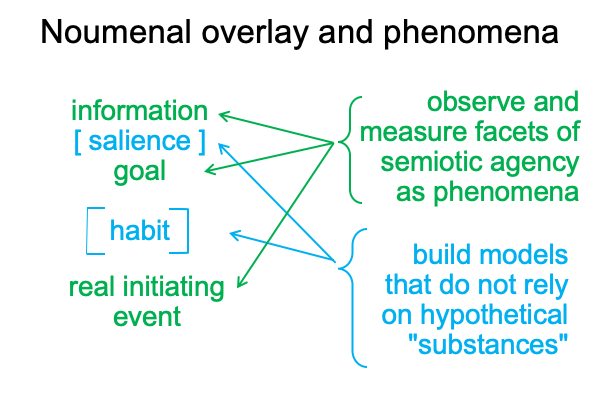0151 Of course, there are caveats.
The authors call them “heuristics”.
They should call them, the three please do’s (P, Q and R).
0152 First (P), please, limit agents to things that are accessible to observation and measurements (see points 0153-0174).
Second (Q), please, do not explain agency by any hypothesized substances or forces other than those already known to modern natural science, social sciences and humanities (see points 0175-0176).
Third (R), please, do not link agency with unproven, speculative physical effects such as subatomic quantum factors, extra dimensions in space, and so on (0177).
0153 Does Sharov and Tonnessen’s dyadic noumenal overlay fit these heuristics?
First, S&T’s semiotic agency [can be objectified by] its phenomena (more or less).
Indeed, the very structure of their noumenal overlay directs the inquirer to those elements that give rise to phenomenaand to those elements that call for models.

0154 This is one of the advantages of biosemiotics compared to phenomenology and cybernetics.
Phenomenologists rely on an intuition that is naturally informed by S&T’s noumenal overlay.
Phenomenologists intuitively ascertain what the noumenon must be. The results are overlaid onto the noumenon, in such a fashion as to yield observable and measurable facets (that is, phenomena). Then, these novel phenomena support novel empirio-schematic inquiry.
0155 For example, the empirio-schematic natural sciences may observe and measure the combustion of a house. Then, they may model the process in terms of reagents (fuel and oxygen), heat release (the natural course of combustion), and initiation (what starts the fire). All these can be observed and measured.
The phenomenologist will say, “That is not sufficient to account for the phenomena.”
After all, someone’s home is on fire.
0156 As soon as the house, as a site for human belonging, is regarded as what the noumenon must be, then empirio-schematics consider phenomena that objectify the home. Social scientists may look into obtaining grants to study the statistics of home fires, in order to assess social causes, as well as civilizational costs and consequences. They collect data and build models.
0157 But, is that enough?
0158 What if a home is characterized as two real elements, a wish and a choice? What if the contiguity between that wish and choice is a habit?
Well, then a cybernetic intellect (relation, thirdness) may bring this new noumenon, choice [habit] wish, along with its related phenomena, into relation with mechanisms that account for the contiguity, habit.
0159 Let me take one more step in the cybernetic paradigm and ask the following question.
What about what people think?
Well, phenomenology applied to the political sciences produces curious noumena, er… models that substitute for… what people think. What people say constitute the corresponding phenomena.
Of course, the classical Positivist’s what is of what people think [cannot be objectified as] what people say must be overcome when the noumenon consists of a response to a relativist one’s initiative (think, “government agency’s action”). Observations and measurements of what people say are conducted by psychometric scientists (think, “surveys”) and modeled on the basis of capitalist and socialist frameworks (that is, specialized scientific languages within the psychometric sciences).
0160 The psychometric sciences are discussed in Original Sin and the Post-Truth Condition, (by Razie Mah, available at smashwords and other e-book venues.) The inquirer may also look at Razie Mah’s blog for the months of July through October, 2024.
Like psychoanalysis, the psychometric sciences aim to substitute capitalist and socialist models in for the noumenon of what people think.
The enterprise is highly lucrative.
